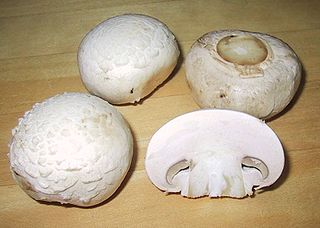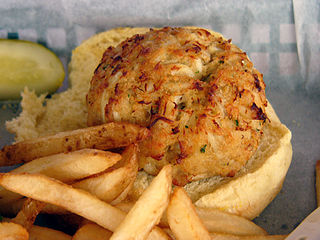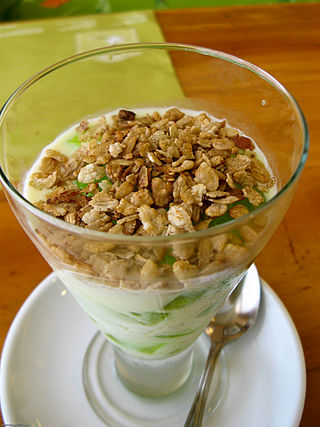
Cornmeal is a meal ground from dried corn (maize). It is a common staple food and is ground to coarse, medium, and fine consistencies, but it is not as fine as wheat flour can be. In Mexico and Louisiana, very finely ground cornmeal is referred to as corn flour. When fine cornmeal is made from maize that has been soaked in an alkaline solution, e.g., limewater, it is called masa harina, which is used for making arepas, tamales, and tortillas. Boiled cornmeal is called polenta in Italy and is also a traditional dish and bread substitute in Romania.

Agaricus bisporus, commonly known as the cultivated mushroom, is a basidiomycete mushroom native to grasslands in Eurasia and North America. It is cultivated in more than 70 countries and is one of the most commonly and widely consumed mushrooms in the world. It has two color states while immature – white and brown – both of which have various names, with additional names for the mature state, such as chestnut, portobello, portabellini, button and champignon de Paris.

Nopal is a common name in Spanish for Opuntia cacti, as well as for its pads. The name nopal derives from the Nahuatl word nohpalli for the pads of the plant.

Suribachi and surikogi are a Japanese mortar and pestle. These mortars are used in Japanese cooking to crush different ingredients such as sesame seeds.

Butternut squash, known in Australia and New Zealand as butternut pumpkin or gramma, is a type of winter squash that grows on a vine. It has a sweet, nutty taste similar to that of a pumpkin. It has tan-yellow skin and orange fleshy pulp with a compartment of seeds in the blossom end. When ripening, the flesh turns increasingly deep orange due to its rich content of beta-carotene, a provitamin A compound.

A crab cake is a variety of fishcake popular in the United States. It is composed of crab meat and various other ingredients, such as bread crumbs, mayonnaise, mustard, eggs, and seasonings. It is then sautéed, baked, grilled, deep fried, or broiled. Crab cakes are traditionally associated with the Chesapeake Bay, in the state of Maryland. Although the earliest use of the term "crab cake" is commonly believed to date to Crosby Gaige's 1939 publication New York World's Fair Cook Book in which they are described as "Baltimore crab cakes," earlier usages can be found such as in Thomas J. Murrey's book Cookery with a Chafing Dish published in 1891.

In Mexico, queso Chihuahua is commonly recognized as a soft white cheese available in braids, balls or rounds and originates in the Mexican state of Chihuahua. In Chihuahua and neighboring states, it is called queso menonita, after the Mennonite communities of Northern Mexico that first produced it, while elsewhere it is called queso Chihuahua. This cheese is now made by both Mennonites and non-Mennonites throughout the state and is popular all over the country.

Hallmark Mystery is an American digital cable and satellite television channel owned by Hallmark Media, a subsidiary of Hallmark Cards. The channel was spun off from sister network Hallmark Channel, and airs family-oriented feature and television films along with a limited number of murder- and mystery-themed television series.

Cotija is an aged Mexican cheese made from cow's milk and named after the town of Cotija, Michoacán. White in color and firm in texture, its flavor is salty and milky. "Young" cotija cheese has been described as akin to a mild feta, while aged (añejo) cotija is more comparable in flavor to hard, aged cheeses like Parmesan. Cotija softens when exposed to heat, but does not melt. Made between the summer and fall seasons; this cheese is made with milk from local cattle and is salted before the fermentation process. The manufacturing processes of most cheeses in Mexico are still rustic and traditional, similar to the manufacturing process that was used upon its invention. Due to the traditional means of production of dairy products in Mexico some dairy products have a conflicting shelf-life which leads to earlier expiration. However, some studies suggest components in the fermentation of Cotija Cheese are natural preservatives that can extend the shelf-life of Cotija Cheese and other food products as well.

A mixiote is a traditional pit-barbecued meat dish in central Mexico; especially in the Basin of Mexico, in which the meat is cooked inside a wrapper, traditionally in the outer skin of an agave leaf.

Queso panela is a fresh cheese common in Mexico made from pasteurized cow's milk. It is also known as queso canasta or queso de la canasta. It is derived from the Greek word for basket cheese. The cheese also has similarities to the Indian cheese paneer.

The piquillo pepper is a variety of chili, Capsicum annuum, having a sweet taste with little to no heat, fruits about 7 cm long, well suited for growing in pots, that is traditionally grown in Northern Spain near the town of Lodosa. Its name is derived from the Spanish for "little beak".

Toriko (トリコ) is a Japanese manga series written and illustrated by Mitsutoshi Shimabukuro. It follows the adventures of Toriko, a Gourmet Hunter, as he searches for rare, diverse foods to complete a full-course meal. On his journey, he is accompanied by a timid chef who wants to improve his skills. Toriko was serialized in Shueisha's shōnen manga magazine Weekly Shōnen Jump from May 2008 to November 2016, with its chapters collected into 43 tankōbon volumes.

Ptitim – sometimes called pearl couscous – is toasted pasta in tiny balls. Despite its name in English, it is not a type of couscous . The pearls are similar to the ones of the Maltese mhamsa.

Opuntia, commonly called the prickly pear cactus, is a genus of flowering plants in the cactus family Cactaceae, many known for their flavorful fruit and showy flowers. Cacti are well-adapted to aridity; however, they are still vulnerable to alterations in precipitation and temperature driven by climate change. Prickly pear alone is more commonly used to refer exclusively to the fruit, but may also be used for the plant itself; in addition, other names given to the plant and its specific parts include tuna (fruit), sabra, sabbar, nopal from the Nahuatl word nōpalli, nostle (fruit) from the Nahuatl word nōchtli, and paddle cactus. The genus is named for the Ancient Greek city of Opus, where, according to Theophrastus, an edible plant grew and could be propagated by rooting its leaves. The most common culinary species is the "Barbary fig".

ʻInamona is a condiment or relish used in traditional Hawaiian cooking made from seed kernels of the kukui nut (candlenuts) and sea salt.

Cactus fries or nopalitos fritos is a side dish originating in the Southwestern United States, made of battered and deep-fried prickly pear paddles or nopales.

Pinipig is a flattened rice ingredient from the Philippines. It is made of immature grains of glutinous rice pounded until flat before being toasted. It is commonly used as toppings for various desserts in Filipino cuisine, but can also be eaten plain, made into cakes, or mixed with drinks and other dishes.
Los Nopalitos is a census-designated place (CDP) in Webb County, Texas, United States. This was a new CDP for the 2010 census, with a population of 62.

Gourmet Detective is an American-Canadian series of made-for-television mystery films based on a book series of the same name from author Peter King that stars Dylan Neal as Henry Ross, a chef turned culinary sleuth and Brooke Burns as Detective Maggie Price. Set in San Francisco, it airs on Hallmark Movies & Mysteries in the US.
































